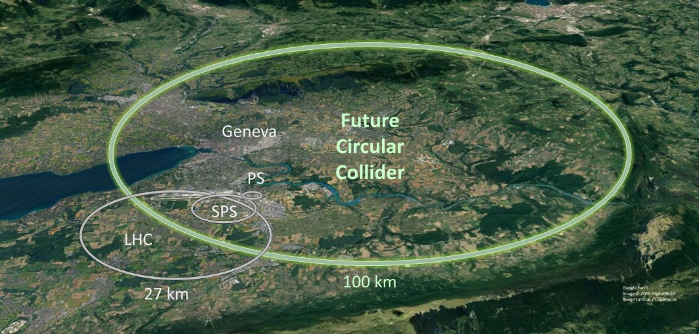
The core objective of the Cockcroft Institute (CI) is to design and develop powerful instruments of discovery, particle accelerators, that enable scientists from many disciplines to elucidate the structure of matter and its underlying dynamics at sub-microscopic distance scales from the molecular to the quark level. Particle physics probes the smallest of these scales, which necessitates the construction of machines accelerating particles to the highest attainable energies and also provides cosmologists with information about the very earliest moments in the history of the universe. On the 19th of June the long-awaited update (performed every 7 years) to the European Strategy for Particle Physics was unveiled and accelerator scientists and engineers at the CI reacted with enthusiasm to the news that was announced.
The key message was that a consensus has emerged in the European particle physics community to prepare a Higgs factory, followed by a future hadron collider with sensitivity to energy scales an order of magnitude higher than those of CERN’s Large Hadron Collider (LHC), while addressing the associated technical and environmental challenges. A Higgs factory is an electron-positron collider with sufficient energy to produce large numbers of Higgs bosons, the particle discovered at the LHC in 2012 which plays a central role in determining the masses of many of the elementary particles.

Many mysteries about the universe remain to be explored: the nature of dark matter, the preponderance of matter over antimatter and the origin and pattern of neutrino masses. The Higgs boson is a unique particle that raises profound questions about the fundamental laws of nature. The study of the properties of this particle is in itself a powerful experimental tool to seek answers to some of these questions and the Higgs factory is a very versatile laboratory for these investigations. However, the production of pairs of Higgs bosons in the same event (a process which is sensitive to the triple Higgs boson coupling) may be the key to understanding the fabric of the universe and for that study the Higgs factory must be superseded by a more powerful hadron collider with significantly higher energy than either the Higgs factory or the LHC.
The 2020 strategy presents exciting and ambitious scientific goals that will drive technological and scientific exploration into new and uncharted territory for the benefit of the particle physics and of society in general. It aims to significantly extend knowledge beyond current limits, to drive innovative technological developments and to maintain Europe’s leading role. In addition to the central thrust around the Higgs boson, the strategy also endorsed the completion of the high luminosity upgrade of the LHC, continued support for long-baseline neutrino oscillation experiments in Japan and the USA, and the exploration of synergies between particle and nuclear physics (e.g. the electron-ion collider in the USA).
Professor Peter Ratoff, the Director of the CI, welcomes these exciting developments and remarked that “the Institute is extremely well positioned to participate in the Higgs factory. For example, we have designed crab cavities and high efficiency klystrons for CLIC, CERN’s electron-positron linear collider project, and we have also been involved in beam dynamics studies for the electron-positron version of CERN’s Future Circular Collider project. So, we already have a foothold in both the linear and circular collider technology options.”
Innovative accelerator technology underpins the physics reach of high-energy and high-intensity colliders. It is also powerful driver for many accelerator-based fields of science and industry. The technologies under consideration include high-field magnets, high-temperature superconductors, plasma wakefield acceleration and other high gradient accelerating structures, bright muon beams, and energy recovery linacs.
Professor Graeme Burt from CI/Lancaster University, who is also the scientific project manager on the HL-LHC UK project, said that “Accelerator engineering has huge possibilities to involve UK industry either by constructing components for large accelerators, such as the LHC luminosity upgrade, or via industrial or medical uses of particle accelerators, like radiotherapy. CI is already focussed in this area through of ASHE doctoral training centre, so it’s really encouraging to see this being promoted in the European strategy”
